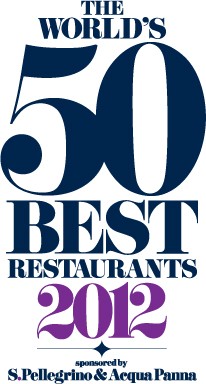
Oh, look, this year's edition of “The World's 50 Best Restaurants”, sponsored by San Pellegrino and its subsidiary Acqua Panna, has come out. Cue the precious online debates and the bored yawns from the rest of the world.
Ranked lists of the best anything are patent bollocks: they necessarily
reflect the devisers' biases and experiences, since no food writer or
group of food writers has ever eaten in every restaurant worldwide.
Smarmy lists like this, especially when they purport to have catalogued the very best, make my sphincter itch.
The restaurants on the list are certainly not bad–they're fine
restaurants which deserve a place in the pantheon of the finest places
to get your grub on–but the order is, like nearly all lists, completely
arbitrary.
]
It's also an unapologetically Euro-centric blowjob of a list. It seems
obvious that they voted for the best of each non-European area and then
slotted them in amongst the offerings in England, France, Italy, Spain
and Denmark. Europe holds 31 of the top 50 slots and 57 of the top 100;
the United States accounts for 8 of the top 50 and 14 of the top 100. Never mind the amazing heritage of Chinese cuisine, the relentless obsession with the best in Japanese cuisine, the echoes of history in Mexican cuisine. No, it only matters if it's European.
The group, to their credit, is developing a list of the fifty best restaurants in Asia, to
be released in February 2013. It's a fair bet, however, that it'll be a list of
restaurants that appeal to Western tastes in Hong Kong, Tokyo,
Singapore, Seoul and possibly Shanghai or Beijing.
The restaurants on the list are also all, without exception, shockingly expensive.
This is less a travel guide than the gustatory equivalent of the Seven
Summits. It's easy to imagine the “mountaineers” who attempt to complete the “World's 50
Best” as the sort of tedious, well-paid professionals whose enjoyment comes not
from the meals themselves, but from achieving that soul-satisfying moment
where the last carefully straight-edged line strikes through the final
item on the list.
Bollocks. It's just like the worldwide expansion of the Guide
Michelin under Jean-Luc Naret, which was swiftly followed by its
worldwide contraction after people realized that sending the arbiters of
French taste in restaurants to non-French restaurants in order to
publish a once-a-year snapshot of the world's most dynamic industry was
swiftly pushing the guide into ignominious irrelevance.
Follow Stick a Fork In It on Twitter @ocweeklyfood or on Facebook! And don't forget to download our free Best Of App here!

